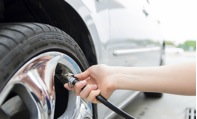Why should I check my tire pressure?
- Your tire pressure helps maximize tire life
- It improves fuel efficiency since underinflated tires take more work (and fuel) to drive
- Helps provide even wear and smoother ride
How do I know my tire’s recommended air pressure?

Look on your vehicle’s door jam placard or pull out your owner's manual, and look up “tires." You should find details including front and rear “PSI" listings. (PSI stands for pounds per square inch.) This number is determined by your vehicle's manufacturer, and it's how you can tell if your tires are properly inflated.
PSI is based on your vehicles:
- Total
weight and size
- Towing
weight capability
- Recommended tire size
It's important to note that you should always use the pressure recommended by your vehicle's manufacturer to ensure optimal vehicle performance and safety. The sidewall of the tire will show a maximum PSI that you should never exceed, but generally speaking, your vehicle’s recommended PSI will be much lower than the max limit. If your vehicle placard/manual recommends a PSI that is higher than the max PSI listed on the tire, you’ve got the wrong tire on your vehicle and should replace it immediately!
Why Is Tire Pressure Important?
According to t he National Highway Traffic Safety
Administration, under-inflated tires have a higher risk of damage and failure.
Not only will they wear out faster if under-inflated, but faster deterioration
can also lead to reduced control of your vehicle, tire blowouts, and crashes.
he National Highway Traffic Safety
Administration, under-inflated tires have a higher risk of damage and failure.
Not only will they wear out faster if under-inflated, but faster deterioration
can also lead to reduced control of your vehicle, tire blowouts, and crashes.
In addition to safety, there's also an environmental and economic benefit to keeping your tires full of air. Gas mileage is reduced by .2% for every 1 PSI below the recommended level. By keeping your tires inflated to the proper pressure, you could save yourself up to 3% in gas mileage, depending on your vehicle and driving habits.
When should I check my tire pressure?
Even new tires with minimal wear can lose air. Factors that can affect tire pressure include:
- Hot or cold temperatures
- Driving distance
- Towing or carrying added weight in your vehicle
Most tire and vehicle manufacturers recommend checking your tire’s pressure every month. Other instances you should immediately check your tire pressure are:
- After hitting a pot hole or curb
- If your vehicle is pulling to one side while driving
- The weather changes from warm to cold
How do I check my tire pressure?

Checking your tire pressure is easy! You can do it at home or at the gas station. Just be sure you check the pressure when your tires are cold, or haven't been driven over a mile in several hours. This will give you the most accurate reading.
The most important piece of equipment you need is an accurate tire pressure gauge. You can find battery-operated digital gauges, or more traditional stick-type gauge found at most gas stations. A decent gauge only costs about $15 - a worthwhile investment for longer tread life and a safe ride.
Make sure you are aware of your manufacturer's PSI when you're checking your tire pressure, and then follow these steps:
- Remove the end caps on your tires' air valves (they’re little, store them somewhere safe so they don’t get lost!)
- Place the tire pressure gauge into the valve stem and press down quickly to get a reading.
- Check the PSI reading. Compare that to your vehicles recommended PSI.
- It can often be tricky to get the gauge to press fully onto the valve, resulting in an incorrect reading. Take a few readings to ensure it’s accurate.
- If the reading is above the recommendation, push in the valve to let out some air.
- If the reading is below the recommendation, fill your tire with air until you reach the ideal level.
Checking your tires’ air pressure only takes a few minutes. This monthly routine maintenance will help save you money and keep you and your passengers safe. If you have any questions, don’t hesitate to call one of our 8 locations for guidance.





